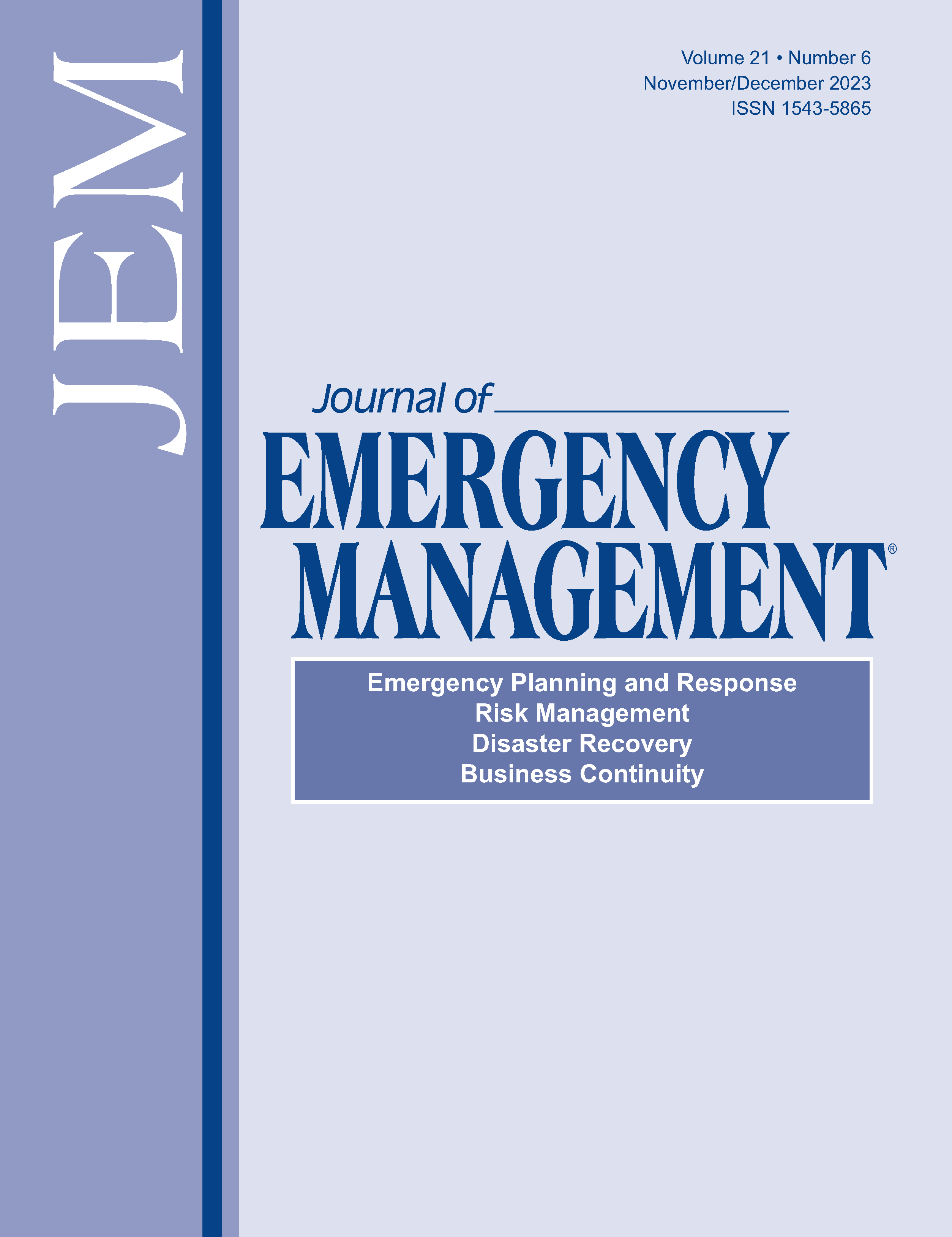Accidental release of chlorine from a cylinder during transport and an emergency response plan: A scenario-based study
DOI:
https://doi.org/10.5055/jem.0780Keywords:
transport of chlorine cylinder, event tree, PHAST software, emergency response planningAbstract
Introduction: This article summarizes our research study on the scenario of an accidental chlorine gas release during transportation and preparing emergency response plan to mitigate the subsequent hazards in urban areas.
Methodology: To conduct the research study, the event tree analysis (ETA), a series of brain storming sessions, and a modeling of consequences of an accident using the Phylogenetic Analysis with Space/Time models (PHAST) software were employed.
Results and discussion: Based on the result of the event tree, 32 initial occurring paths and 20 eventual occurring paths are identified as the outcome. The evacuation time is about 41 seconds, which is very short, and the odds of casualties are estimated at 99 percent within a radius of 140-192 m from the release site, 50 percent within a radius of 202-599 m, and 1 percent within a radius of 758 m.
Conclusion: Along with the use of consequence modeling, the development of the ETA can be effective in emergency preparedness. In the case of a chlorine gas release, it would not be possible to effectively control the source of release. Furthermore, the result indicates that in a major city like Tehran, the application and transport of chlorine gas can be a serious challenge.
References
Masoumi G, Maniey M, Aghababaeian H, et al.: Lessons learned from a chlorine gas leakage in Dezful city, Iran. Disaster Med Public Health Prep. 2022; 16(2): 818-824.
Gangopadhyaya RK, Dasa SK, Mukherjeeb M: Chlorine leakage from bonnet of a valve in a bullet a case study. J Loss Prev Process Ind. 2005; 18: 526-530.
Ilić P, Ilić S, Stojanović Bjelić L: Hazard modelling of accidental release chlorine gas using modern Tool-Aloha software. Qual Life. 2018; 16: 1-2.
Yousef GM, Alizade M, Por Ahmad Saraee AR: Emergency management in chlorine gas incidents. J New Res Approach Manag Account. 2021; 5(53): 204-214 [In Persian].
Oggero A, Darbra RM, Muñoz M, et al.: A survey of accidents occurring during the transport of hazardous substances by road and rail. J Hazard Mater. 2006; 133(1-3): 1-7.
Nowacki G, Krysiuk C, Kopczewski R: Dangerous goods transport problems in the European Union and Poland. TransNav. 2016; 10(1): 143-150.
Pandya N, Marsden E, Floquet P, et al.: Toxic releases dispersion modelling with PHAST: Parametric sensitivity analysis 2008; 13: 179-186.
Preinhaelter J, Hillairet J, Milanesio D, et al.: Simulation analysis of propylene storage tank leakage based on ALOHA software. IOP Conf Ser Earth Environ Sci. 2019; 267(4): 042038. DOI: 10.1088/1755-1315/267/4/042038.
Abdullah S: Application of CHARM® for studying chemical dispersion due to accidental release. WIT Trans Ecol Environ. 2014; 181: 705-716.
Afshin J, Ali KA, Abdorasoul G: Geographical survey of chlorine gas leakage at the chlorination station of ABFA company using ALOHA software, case study: Lar station. Environ Hazards Manag. 2019; 5: 435-448.
Ruj B, Chatterjee PK: Toxic release of chlorine and off-site emergency scenario—A case study. J Loss Prev Process Ind. 2012; 25(3): 650-653.
Hosseini SH: Assessment and modeling of chlorine release in urban region: A case study in water supply of Eyvan city, Iran. J Basic Res Med Sci. 2016; 3: 7-14.
Tseng JM, Liu MY, Chang RH, et al.: Emergency response plan of chlorine gas for process plants in Taiwan. J Loss Prev Process Ind. 2008; 21(4): 393-399.
Brzozowska L: Computer simulation of impacts of a chlorine tanker truck accident. Transp Res D Transp Environ. 2016; 43: 107-122.
Vílchez JA, Espejo V, Casal J: Generic event trees and probabilities for the release of different types of hazardous materials. J Loss Prev Process Ind. 2011; 24(3): 281-287.
Hemmat: Shekhfazlollah intersection. Available at https://earth.google.com/web/@35.75393568,51.34533785,1437.20281442a,3525.46676188d,35y,0h,0t,0r. Accessed March 22, 2022.
Pizzi NG: Water Treatment. Denver, CO: American Water Works Association, 2010: 170-220.
Chlorine Handling Manual: Available at http://www.hydroinstruments.com/files/Chlorine%20Handling%20Manual%202016%2005%2006.pdf. Accessed May 18, 2022.
Ton Cylinder for Chlorine Gas—China Chlorine Gas Cylinder and Chlorine Cylinder [Internet]. Available at https://ludonggas.en.made-in-china.com/product/oOeGdSJjLzRD/China-Ton-Cylinder-for-Chlorine-Gas.html. Accessed November 26, 2022.
Meteorological Data Request System: Available at https://data.irimo.ir. Accessed March 31, 2022.
Meteorological Monthly: Available at http://www.tehranmet.ir/page-Default/fa/0/form/pId14. Accessed March 31, 2022.
Khalesi B, Mansouri Daneshvar MR: Comprehensive temporal analysis of temperature inversions across urban atmospheric boundary layer of Tehran within 2014–2018. Model Earth Syst Environ. 2020; 6(2): 967-982.
Saroha AK: Safe handling of chlorine. J Chem Heal Saf. 2006; 13(2): 5-11.
Soman A, Sundararaj G, Devadasan S: Consequence assessment of chlorine release. Process Saf Prog. 2012. DOI: 31. 10.1002/prs.11479.
Comparative Statistics of Tehran Fire Department in 2017: Available at https://data.tehran.ir/%D9%86%D8%AA%D8%A7%DB%8C%D8%AC-%D8%AC%D8%B3%D8%AA%D8%AC%D9%88/smid/1182/reftabid/93?key=%D8%A2%D8%AA%D8%B4+%D9%86%D8%B4%D8%A7%D9%86%DB%8C. Accessed March 31, 2022.
Tehran City (Iran): Municipal districts—population statistics, charts and map. Available at https://www.citypopulation.de/en/iran/tehrancity. Accessed March 31, 2022.
CDC: Chlorine: Lung damaging agent. Available at https://www.cdc.gov/niosh/ershdb/EmergencyResponseCard_29750024.html. Accessed November 25, 2022.
Khankeh HR, Amin S, Nakahee M, et al.: National Tools for Health Assessment in Emergencies and Disasters. Evin, Iran: University of Social Welfare and Rehabilitation, 2016: 116-120. ISBN: 978-600-6442-64-8 [In Persian].
Jayakumar C, Isac S, Prasad DMR: Emergency response plan for methane and chlorine with dispersion modelling using CAMEO. Int J Occup Saf Ergon. 2022; 28(3): 1802-1810. Available at https://pubmed.ncbi.nlm.nih.gov/34126871. Accessed February 9, 2023.
Search Results: Available at https://www.amar.org.ir/english/Search-Results?search=Thematic-statistics/treatment. Accessed April 1, 2022.
Published
How to Cite
Issue
Section
License
Copyright 2007-2025, Weston Medical Publishing, LLC and Journal of Emergency Management. All Rights Reserved.
Leave Nobody Behind: Emergency Management in a More Inclusive Way is a trademark of Journal of Emergency Management






